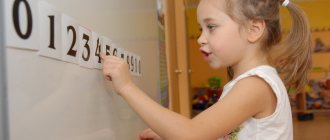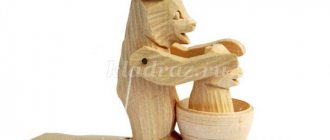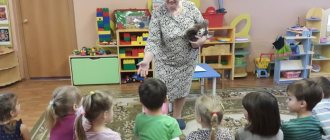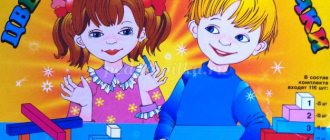Integration of educational areas: cognitive development, speech development, social and communicative development, artistic and aesthetic development, physical development.
Tasks:
"Cognitive development":
introduce a geometric figure - a ball; ordinal number “third”; practice counting up to 3. Activate mental activity through resolving a problem situation. Develop memory, attention, logical thinking. Activate and systematize children’s knowledge and skills.
“Social and communicative development”:
introduce children to the basic rules of interaction with peers in the process of activity, a tolerant attitude towards others, the ability to listen to each other. Create an atmosphere of creative exploration.
"Speech development"
expansion and activation of the dictionary with words: ball, third. Consolidating the use of tree names in speech: birch, oak, spruce, maple.
"Physical development":
improve motor skills.
“Artistic and aesthetic development”:
practice the ability to carefully paint over a silhouette without going beyond the contours of the image.
Methods and techniques:
Practical – games, game exercise;
verbal - conversation, questions, reading a poem;
visual - observations, looking at pictures
Materials and equipment:
demonstration: geometric shapes, a plot picture depicting rectangular objects; a picture depicting objects of different shapes; ball, cube; pictures depicting spruce, birch, oak, ball.
handouts: pictures with silhouette images of trees, colored pencils.
Forms of organizing joint activities
| Children's activities | Forms and methods of organization |
| Visual activities | 1. Task “Paint the tree.” Goal: to consolidate the ability to select the appropriate pencil color to depict parts of a tree. |
| Communication activities | 1. Reading the poem “Ball”. Goal: to be attentive and interested listeners. |
| Cognitive - research | 1. Exercise “Find the ball” Purpose: to consolidate the ability to find objects of the same shape. 2. Game “What to roll?” Goal: teach to think logically by comparing objects. 3. Game exercise “Count the leaves”, “Count the trees”. Goal: to consolidate ordinal counting up to 3, the ability to determine which tree a leaf comes from. |
| Physical activity | 1. Physical education. Goal: activation of motor activity of children. They know how to combine movements with the words of a poem. 2. Sedentary game “Catch and Name” Purpose: to practice catching a ball, to consolidate knowledge of trees. |
Logic of educational activities
| Activities of the teacher | Pupils' activities | Expected results |
| 1. Organizing time. Reviewing what we have learned about geometric shapes Task 1. Includes children in educational activities: Invites them to look at geometric shapes and name them. Task 2. Shows a plot picture and offers to find and name rectangular objects. Task 3. Name any geometric figure. | Show interest in the upcoming topic. Answer questions. They enter into dialogue and offer possible answers. Children name objects that have this shape. | The task is accepted by the children; there is motivation to achieve results in collaboration with the teacher and children. |
| 2. Reading the poem "Ball". I inflate the balloon. I roll it around like a ball, throw it up, and catch it again. I look at his form. It is round, just like a flat circle. But he is a great friend to everyone around. The same shape is an orange, a watermelon, a ball, and a tangerine. I will call the figure that I can roll a ball. | Children listen to a poem. | Interest and desire to listen to the poem are aroused. |
| 3. Exercise "Find the ball." Shows a ball figure. | Children find spherical objects in the picture. | The mental activity of children is activated. |
| 4. Game "What to roll." Draws a line on the floor. Questions: Why does the ball roll faster? Which is more stable: a ball or a cube? | Two children roll a cube and a ball to this line. Children conduct a dialogue with the teacher. Answer questions. | The ability to conduct a coordinated dialogue and be friendly, correct interlocutors has been developed. |
| 5. Counting to 3. Ordinal number “third” . Places 3 pictures of trees (birch, spruce, oak) on the dock. Offers to count the trees and compare their height and thickness. - Name the first tree. (Birch.) - Name the second tree. (Spruce.) - Oak is the third tree. - What kind of tree is birch? - What type of spruce? — What kind of oak? | Children count trees, compare them by height and thickness. Answer questions. | Understand and are able to complete tasks |
| 6. Game exercise “Count the leaves.” He attaches oak, maple, and birch leaves to the board and asks them to name which leaves they are and from which tree. -Which sheet is the first? Second? Third? | They look carefully and name the leaves and answer questions. | Understand and are able to complete tasks |
| 7. Physical education. Offers to play a game, recites a poem: Pine . There is a pine tree in the yard, it reaches towards the sky. Poplar grew up next to her, he wants to be more authentic. A strong wind blew and shook all the trees. The branches bend back and forth, the wind shakes them, bends them. Let's squat together - One, two, three, four, five. We warmed up from the heart and went to the place again. Maple. The wind quietly shakes the maple, tilts to the right, to the left: Once - tilt and twice - tilt, The maple leaves rustled. | Children perform movements and actions behind the teacher. Standing on one leg, stretch - arms up, then do the same while standing on the other leg. Tilts the body back and forth. Hand jerks in front of the chest. Squats. They walk in place. Feet shoulder-width apart, hands behind the head, body tilted to the left, right. | They are able to perform movements and actions for the teacher in accordance with the poetic text. |
| 8. Task “Paint the tree” . Offers each child a picture with a silhouette image of trees. Task: color the second tree yellow, the third green, the first red. | Children sit at tables and complete the task. | They understand and are able to complete tasks. |
| 9. Summary of the lesson. Sedentary game "Catch and name". Throws a ball to each child and asks them to name the tree. Clarifies: which exercise or task was the easiest, most difficult, fun, etc. Makes sure that the children’s answers are complete sentences. | Children catch the ball and say the names of the trees. Children share their impressions of past activities | They know and name the names of trees and can talk about past activities. |
Didactic games for the development of quantitative concepts in children of the middle group
Game "Couples"
Goal: to develop counting skills. Develop attention.
Progress of the game: children are given 6 cards with different numbers of objects. The tokens are face down. The first player takes a token and compares the number of items on the token with his card. If the child has the same number of certain objects with a token, then he keeps the token for himself and covers the card with it. At the same time, the child explains why he keeps the token for himself. The one who closes his card the fastest wins.
Game "Half to Half"
Goal: to consolidate counting skills, continue to teach how to correlate two sets by the number of objects.
Progress of the game: look at the cards cut into 2 parts, count the number of objects on them. Invite the children to connect the parts of the card so that there are the same number of objects on the left and right, and explain their choice.
Game “Treat the squirrels with mushrooms”
Goal: to develop children’s ability to compare two groups of objects based on counting, to establish equality and inequality of two sets.
Progress of the game: Guys, squirrels came to visit us. Let's treat them with mushrooms. Each squirrel should be given a mushroom. Place the squirrel with your right hand from left to right, leaving windows between them. Did all the squirrels have enough mushrooms? How many squirrels? How many mushrooms? What needs to be done to make them equal? I propose to equalize in two ways: by adding and subtracting. Are there equal numbers of squirrels and mushrooms? How else can you say it? The squirrels really enjoyed playing with you.
Game "Carrots for Bunnies"
Goal: to develop children’s ability to compare two groups of objects based on counting, to establish equality and inequality of two sets.
Progress of the game: Guys, bunnies came to visit us. Let's treat them to carrots. Each bunny should be given a carrot. Place the bunnies with your right hand from left to right, leaving windows between them. Did all the bunnies have enough carrots? How many bunnies? How many carrots? What needs to be done to make them equal? How many bunnies and carrots?
Game "Butterflies and Flowers"
Goal: to develop children’s ability to compare two groups of objects based on counting, to establish equality and inequality of two sets.
Progress of the game: Children, look how beautiful the butterflies are. They want to play with you. Now you will become butterflies. Our butterflies live on flowers. Each butterfly has its own house - a flower. Now you will fly around the clearing, and at my signal you will find yourself a house - a flower. Butterflies, fly! Butterflies, to the house! Have all the butterflies had enough houses? How many butterflies? How many flowers? Are they equal? How else can you say it?
Game "Bugs on the leaves"
Goal: to develop children’s ability to compare two groups of objects based on counting, to establish equality and inequality of two sets.
Progress of the game: Children, look how beautiful the bugs are. They want to play with you. Now you will become bugs. Our bugs live on leaves. Each bug has its own house - a leaf. Now you will fly around the clearing, and at my signal you will find yourself a house - a leaf. Bugs, fly! Bugs, into the house! Did all the bugs have enough houses? How many bugs? How many leaves? Are they equal? How else can you say it? The bugs really enjoyed playing with you.
Game "Find a Pair"
Goal: to develop the ability to compare two groups of objects based on counting, to establish equality and inequality of two sets.
Progress of the game: The teacher says: look, we have cards with different numbers of toys. But they are all mixed up. They must be folded so that two cards have the same number of objects. I will give these cards to you, and you will look for a pair. Why did you get together? How many apples? How many pears?
Middle group. Junior preschool age. Children 4 - 5 years old
Summary of a lesson on FEMP in the middle group “Comparison of numbers 3 and 4, counting according to a pattern, riddles. Seasons - autumn" Program tasks: - quantity and counting : comparison of numbers 3-4; counting according to a model, riddles - orientation in time: seasons (autumn. - orientation in space: left, right Integration: Cognition, artistic creativity (drawing, Goals: Teach: - count objects (within 4, ...
Continuation. Didactic exercises that promote the process of mastering quantitative and ordinal counting in the middle group
Continuation. Exercises aimed at teaching quantitative and ordinal counting (at the initial stage of training. Quantitative counting : - learning to count using movements, - For example, - *it is suggested to perform different tasks with counting movements: jumping on both legs (on...






